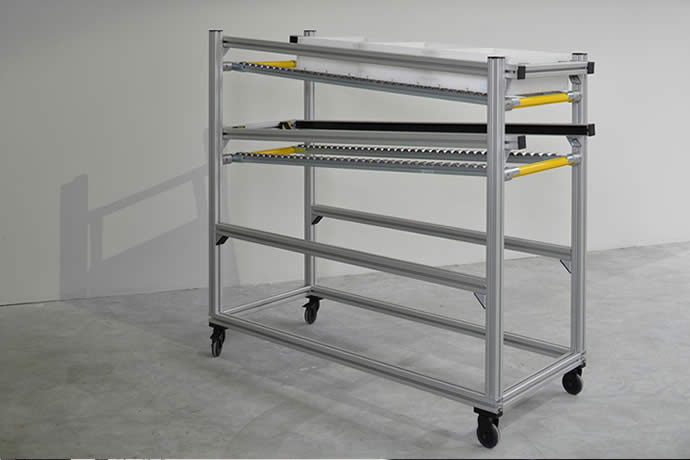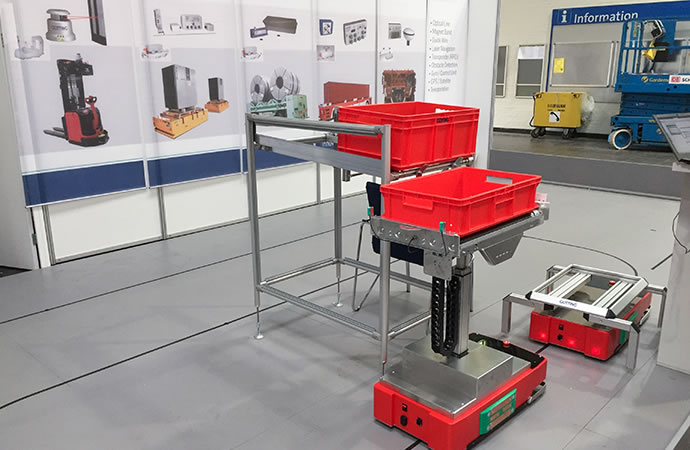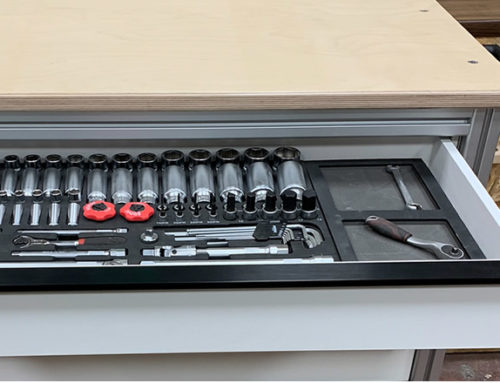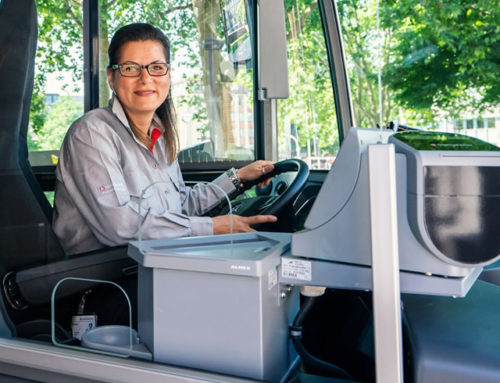“You can never be ‘lean enough’.”
An interview with our lean production expert Stefan Armbruster.
When crates and workpieces in production seem to move by magic, it is often low-cost automation – also known by its Japanese name Karakuri – that is at play. We asked our expert on lean production, Stefan Armbruster, how companies can make the most effective use of mechanical automation and what kinds of perils and pitfalls they need to watch out for. He is also a regular contributor to the “LCIA and Karakuri Kaizen®” seminar at the CETPM Institute run by Ansbach University of Applied Sciences.
Why should companies utilise low-cost automation?
As an integral component of the lean philosophy, Karakuri solutions help avoid many types of waste in companies. When companies really take continuous improvement and the fight against all types of waste seriously, they almost automatically arrive at the point of asking how they can further increase a worker’s contribution to value creation. You can’t be happy with the status quo. You can never be ‘lean enough’. Continuous improvement means wanting to get better and better all the time. Karakuri is one way to get better.
How does mechanical automation help deliver improvement?
There are lots of processes that you sometimes simply can’t improve on without some extra tools. To ensure staff are spending more time on activities that add value, you need to think about automating repetitive tasks. Having people lift and shift crates almost always results in waste.
Is automation worthwhile for such simple tasks?
If productivity increases it pays off very quickly, so long as the mechanical systems are not expensive. In the case of improvements in car making, a time saving of 0.05 minutes is quite possible. Karakuri is about applying the methods of lean production to automation. You can achieve astounding results with pretty simple means.
What is the difference between mechanical automation and electrical automation?
On the one hand, the difference lies in how fast it can be implemented. A traditional automation project lasts months and requires a huge budget. A Karakuri solution can be put together in a few days and costs just a fraction of a traditional automation solution. On the other hand, you need fewer parts and no electricity, sensors, controllers or programming – i.e. no specialist expertise. That means low maintenance costs, because staff can fix a fault themselves. The plant won’t grind to a halt while everyone waits for an expert to turn up with his laptop.
It sounds like mechanical and traditional automation are opposing forces.
Quite the opposite in fact. Depending on the task at hand, they can complement each other very well. Low-cost automation uses a combination of muscle power, leverage and gravity. All the same, there’s no getting around the laws of physics. If there is no other solution, you have to revert to traditional drives. In fact, that’s often essential when it comes to lifting heavy loads or moving loads very high up. One typical case is when components need to be lifted over logistics routes to get to the workstation.
When building hybrid Karakuris, it’s important that the logic component is moved into the mechanics so that the number of sensors and controllers can be minimised. Think of it like a grandfather clock, where the drive is merely responsible for pulling the weights back up. The drive starts when the weights are at the bottom and then pulls them back to the top. All the complex functions such as the hands that show the time and the striking mechanism are controlled by the mechanics of the clockwork. Both systems are entirely independent and can be separated from each other again quickly.
OK, so this is my first Karakuri. What’s the best way to get started?
By trying things out. In our training courses, we start with a fun task such as redirecting a force from A to B in at least 10 seconds. Participants have to think about what type of movements they can use to reliably achieve this time delay. On the surface of it, the “what-happens-then” machine is a bit of fun. However, you develop virtually all the principles you will need later on to complete a genuine task quickly and efficiently. It is only at the end of this course that participants put together a simple small load carrier handling system.
Does Karakuri just fall into place?
The advantage is that you can achieve a lot with simple means. You can also work everything out for yourself, as long as you have enough time. Naturally, one of our training courses also offers the benefit of our experience, such as in how to handle rising and falling counterforces. Of course, people may well work that out for themselves over time, but the learning curve is steeper when someone shows you how.
How is a training course conducted?
We often use an external teaching factory because it has everything we need and helps avoid disruption to production operations. We also offer on-site training courses for larger customers. When there is a very specific problem to be overcome, it’s essential to work with the actual crates and components that are involved.
What kind of mistakes have you seen people make when implementing Karakuri for the first time?
Lots of people try to develop the mechanics on paper first. That almost always goes wrong. It’s much better to take the workpiece, build a prototype and continuously refine it. That’s the power of continuous improvement. When you start by designing a CAD model, build everything then find out that a flap won’t move because of friction, you’ve wasted a lot of time. If you start with the flap and try it out straight away, you’ll have less rebuilding to do further down the line.
A CAD model should only be drawn up later on, i.e. when the Karakuri is in proper working order. This makes it the “A” for “Act” in the PDCA cycle, which in this case means documentation or standardisation.
Why shouldn’t companies just buy in Karakuri solutions like they do with automation solutions? Won’t they save even more time that way?
From a management point of view, that sounds tempting, but it’s bad for the motivation and expertise of the workforce. We’re talking about continuous improvement. If a team has developed something itself, it can also repair and continuously refine the application itself. Try it out with an external solution or with a programmed linear unit.
In the long run, the expertise will be a real gold mine for two reasons: Firstly, because the fight against waste goes on. And, secondly, because staff develop the skills to apply the principles of Karakuri to other issues. If you can see opportunities and utilise them straight away, without having to wait around for an investment decision, you will benefit the most from lean production.
The Toyota formula for the value of a company is also a good indicator. The formula is:
Company value = number of employees x skills x motivation
You need fewer employees to order a solution than to develop it. The employees’ skills do not need to be developed and nobody is motivated, either. Ultimately, that reduces the company’s value.
Where do the ideas for Karakuri projects come from in the company?
Allow me to answer that with a question: Who is responsible for quality in a company? Who is responsible for success? In lean production, there can be only one answer – everyone! Every employee is responsible and every employee can come up with that all-important idea for how to make something better. It doesn’t have to be an engineer or one of the workers who builds the factory equipment.
What constitutes a good Karakuri building kit system for companies?
Karakuri is not a discipline in its own right, but rather an element of lean production. A good Lean Production Building Kit System will contain suitable components. These must be low-maintenance and self-explanatory. The components shouldn’t require any special machining or special tools. Ideally, a saw and a hex key should be all that is needed. It’s also essential that elements can be adjusted and replaced quickly.
The building kit system should also contain all the components needed to ensure moving assemblies can be built safely and reliably. Such components would include pivot bearings, bushings, castors, roller elements, roller conveyors, etc. What’s more, it’s crucial that staff have access to parts that enable low-friction movements. This is essential if mechanical assemblies need to be actuated by light components (such as empty small load carriers).
Besides, Karakuri is not necessarily linked to a building kit system. When it comes to handling the smallest of parts, companies may need to manufacture special components that have been optimised for this purpose.
What are the limits to Karakuri?
Since we’re talking about simple mechanics, anything is possible in theory. In practice, not everything is feasible. You could, of course, develop a Karakuri to turn concrete slabs. The only problem is – how expensive would that be? Massive systems like these aren’t easy to modify either, meaning they aren’t automatically CIP friendly.
Nonetheless, there are exceptions here, too. For example, there are ingenious Karakuri solutions for changing the heaviest of tools that pay for themselves very quickly, even despite their complex design.
Are you always on the lookout for the latest news from the world of lean production? Then we have the perfect solution for you. Simply subscribe to the item blog by completing the box at the top right!









